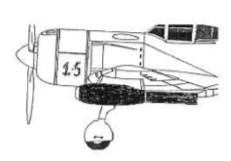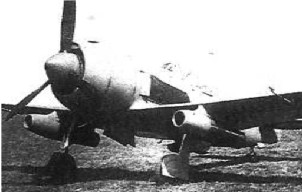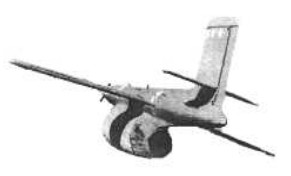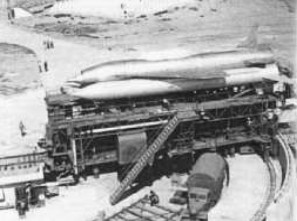Updated: 12-Mar-2020
Prolific ramjet designer starting during WWII with two engines mounted under the wings of the LAGG-3 aircraft in 1942, and continued well into the Cold War.
-The PVRD-43 ramjet is from1946 and was installed in an La-7S.

"PVRD-43 under an La-7S"
-PVRD means “Priamototochnyi Vozodushno Reaktivnyi Dvigatel.
-The PVRD-430s (sometimes VRD-430) were tested in an La-126 in the summer of 1946. This aircraft reached a speed of 800 km/h. at an altitude of 8,000 meters. There was one VRD-430 installed under each wing of the aircraft.

"VRD-430"
-We See two VRD-430s in an experimental La-9 that later was renamed La-138. These engines gave 300 Kgf of thrust, and in trials that were done in 1947, the aircraft speed increased with about 110 km/h.

“PVRD-430 ramjet”
-The same plane was tested with pulsejets such as the RD-13 (it was the La-9RD aircraft), which turned out not to be that maneuverable.
-The RD-13 pulsejet or “pulsating athodyd” was not a Bondariuk engine.
-From Bondaryuk was the ID-012U ramjet giving 7,750 kgf of thrust and running on air/kerosene. This ramjet was used in the Burya cruise missile.
-The Bondariuk RD-018 was another ramjet, which was installed in the Buran missile. The engine had a diameter of 1.8 meters.
-In 1957, the Bondariuk RD-020 gave 10,600 Kgf of thrust.
-This was another ramjet for the Buran cruise missile (besides, it used four Glushko or Ysayev (see both)) rockets to reach a Mach 3.1 cruise speed.
-The Bondariuk ramjets for Burya and Buran missiles were also known as "EKR".
-The YARD-O'KB-670 was an exceptional project from 1958 and it was a nuclear/ammonia + alcohol ramjet that delivered 170,000 Kgf of thrust for 500 seconds.
-It had one chamber and 4 nozzles and it was made for an ICBM (intercontinental ballistic missile), and was a contemporary of Glushko.
-Bondariuk continued to work with Lavotchkin and they prepared the RD-800 and RD-900 ramjets for the La-17 cruiser missile.

"La-17"
-The RD-900 was a ramjet of 40 inches in diameter and delivered 800 kgf of thrust at Mach 0.76 and at 5000 feet altitude. It consumed 70 OCT gasoline.
-Later models than the La-17 already used Mikulin RD-9B turbojets, which were removed from MiG-19s and minimally remanufactured to last 10 to 30 hours, ie, expendable. That is why the variants were designated RD-9BK, K and KR.
-The letter “K” indicated "Short Life". Specifically the RD-9BKR lasted 10 hours.
-The La-17 missiles used R11-300 engines that were removed from MiG-21s. These engines were designated R-11K.
-And in China, where these UAVs were manufactured under license, they used Wopen-6 (RD-9B) engines that were manufactured under Russian license.
-For the Lavochkin La-350 missile type ICCM (Inter Continental Cruise Misile), a large ramjet was used. This was the RD-012U, which ran on air and kerosene. This missile was also known as Burya.
-It was designed at OKB-670, and it delivered 17,085 lbf of thrust or nearly 9,000 Kgf at Mach 3.

“The La-350 winged cruiser”
-This missile's fuselage is the engine itself.
-For launching it has two imposing Isayev S2-1100, booster engines that were later replaced by S2-1150s.
-These engines have four combustion chambers.
-We see their nozzles in the picture below.

“The Burya ready for launching”
-The huge Bondariuk ramjet nozzle can be seen in the picture above.
From appendix 9: Complementary information to the main text. Other rocket engines:
-RD-012U
-RD-018
-RD-020
-YaRD OKB-670, nuclear/with alcohol+ammonia.
-Sometimes spelled as Bondaryuk. They made the EKR ramjet.


